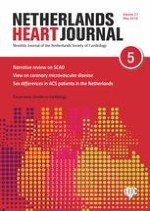Introduction
MINOCA diagnostic criteria elements
| |
1 | AMI criteria, including: |
(a) Positive cardiac biomarker: defined as a rise and/or fall in serial levels, with at least one value above the 99th percentile upper reference limit and | |
(b) Corroborative clinical evidence of infarction, including any of the following: | |
– i. Ischaemic symptoms (chest pain and/or dyspnoea) | |
– ii. Ischaemic ECG changes (new ST-segment changes or LBBB) | |
– iii. New pathological Q waves | |
– iv. New loss of viable myocardium on myocardial perfusion imaging or new RWMA | |
– v. Intracoronary thrombus evident on angiography or at autopsy | |
2 | Absence of obstructive CAD on angiography (defined as no lesions ≥50%) |
3 | No clinically apparent cause for the acute presentation |
Vasospastic angina diagnostic criteria elements
| |
1 | Nitrate-responsive angina—during spontaneous episode, with at least one of the following: |
(a) Rest angina—especially between night and early morning | |
(b) Marked diurnal variation in exercise tolerance—reduced in morning | |
(c) Hyperventilation can precipitate an episode | |
(d) Calcium channel blockers (but not beta-blockers) suppress episodes | |
2 | Transient ischaemic ECG changes—during spontaneous episode, including any of the following in at least two contiguous leads: |
(a) ST-segment elevation ≥0.1 mV | |
(b) ST-segment depression ≥0.1 mV | |
(c) New negative U waves | |
3 | Coronary artery spasm—defined as transient total or subtotal coronary artery occlusion (>90% constriction) with angina and ischaemic ECG changes either spontaneously or in response to a provocative stimulus (typically acetylcholine, ergonovine or hyperventilation) |
Clinical disorder
| ||
1 | Epicardiac coronary disorders (MI type 1) | (a) Atherosclerotic plaque rupture |
(b) Ulceration | ||
(c) Fissuring | ||
(d) Erosion or coronary dissection with non-obstructive CAD | ||
2 | Imbalance between oxygen supply and demand (MI type 2) | (a) Coronary embolism |
(b) Coronary artery vasospasm | ||
3 | Coronary endothelial dysfunction (MI type 2) | (a) Coronary microvascular dysfunction |
4 | Myocardial causes | (a) Cardiomyopathy |
– i. Takotsubo syndrome | ||
– ii. Dilated | ||
– iii. Hypertrophic | ||
(b) (Peri)-myocarditis | ||
(c) Myocardial trauma or injury | ||
(d) Tachyarrhythmia-induced infarct | ||
5 | Non-cardiac causes | (a) Renal impairment |
(b) Pulmonary embolism | ||
Clinical manifestations of vasospastic angina
Risk factors and pathogenesis
Evaluation of patients with vasospastic angina
Non-invasive evaluation
Invasive evaluation
Indication and pharmacological agents for invasive provocative coronary vasospasm testing
Class I (strong indication)
|
History suspicious of vasospastic angina without documented episodes: – Nitrate-responsive rest angina – Marked diurnal variation in symptom onset/exercise tolerance – Rest angina without obstructive coronary artery disease – Unresponsive to empiric therapy |
Presentation with acute coronary syndrome in the absence of a culprit lesion on angiography |
Unexplained resuscitated cardiac arrest |
Unexplained syncope with antecedent chest pain |
Recurrent rest angina following angiographically successful PCI |
Class IIa (good indication)
|
Invasive testing for non-invasively diagnosed patients unresponsive to drug therapy |
Documented spontaneous episode of vasospastic angina to determine the ‘site and mode’ of spasm |
Class IIb (controversial indication)
|
Invasive testing for non-invasively diagnosed patients responsive to drug therapy |
Class III (contra-indication)
|
Emergent acute coronary syndrome |
Severe fixed multi-vessel coronary artery disease including left main stenosis |
Severe myocardial dysfunction |
No symptoms suggestive of vasospastic angina |
Invasive provocative coronary vasospasm testing protocol
Prior to procedure:
| ||
Withhold for 48 h | Long-acting calcium antagonists | |
Withhold for 24 h | Caffeine | |
Long-acting nitrates | ||
Short-acting calcium antagonists | ||
α-Blockers | ||
β-Blockers | ||
ACE inhibitor | ||
Angiotensin receptor blockers | ||
Renin inhibitors | ||
Aldosterone inhibitors | ||
Withhold for 4 h | Sublingual nitrates | |
During procedure:
| ||
Agent | Administration |
Dose
|
– Acetylcholine | Intracoronary (manual) bolus injection | LCA: 20/50/100/200 µg RCA: 20/50/80 µg over 20 s with an at least 3‑min interval between each injection |
Intracoronary (continuous) infusion | LCA or RCA: Incremental doses of 0.288/2.88/28.8/288 µg during 3 min (maximal highest dose 864 µg) | |
– Ergonovine | Intracoronary (continuous) infusion | LCA: 16 µg/min during 4 min (maximal dose 64 µg) RCA: 10 µg/min during 4 min (maximal dose 40 µg) |
Intravenous (continuous) infusion | Incremental doses of 50/100/150 µg during 5 min | |
